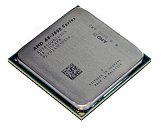- Joined
- Oct 9, 2007
- Messages
- 47,421 (7.51/day)
- Location
- Hyderabad, India
| System Name | RBMK-1000 |
|---|---|
| Processor | AMD Ryzen 7 5700G |
| Motherboard | ASUS ROG Strix B450-E Gaming |
| Cooling | DeepCool Gammax L240 V2 |
| Memory | 2x 8GB G.Skill Sniper X |
| Video Card(s) | Palit GeForce RTX 2080 SUPER GameRock |
| Storage | Western Digital Black NVMe 512GB |
| Display(s) | BenQ 1440p 60 Hz 27-inch |
| Case | Corsair Carbide 100R |
| Audio Device(s) | ASUS SupremeFX S1220A |
| Power Supply | Cooler Master MWE Gold 650W |
| Mouse | ASUS ROG Strix Impact |
| Keyboard | Gamdias Hermes E2 |
| Software | Windows 11 Pro |
Some investors in AMD, who purchased company stock between October 27, 2011 and October 18, 2012, filed a class action lawsuit against AMD, through law firm Robbins Geller Rudman & Dowd. The class action alleges that AMD and its officers and directors committed violations of the US Securities Exchange Act of 1934. AMD allegedly misled its investors over how popular its first generation "Llano" desktop APU would get, claiming that there were much greater prospects for the APU than it actually ended up selling.

The law firm detailing its suit writes:
When AMD announced its Q2-2012 results in July of that year, it became clear that there really wasn't the kind of demand for the APU that AMD was playing up, AMD in its IR release stated that the markets where it most expected the APU to sell - China and Europe, had lukewarm reception of "Llano." This caused a fire-sale of AMD stock, when it saw a fall by almost 25 percent on extremely heavy trading volume. In the following quarter, on October 28, 2012, AMD announced a decline in its gross margins for Q3 2012 declined 31 percent QoQ, due in part to the $100 million inventory write-down, following which AMD stock declined another 17 percent in a flash.
The Plantiff seeks to recover damages, who are represented by Robbins Geller, a firm that specializes in class action suits against companies that mislead their investors in a very big way. It would be interesting to see how this case plays out, given that readers of content on sites like ours most likely knew how fast AMD's K10 CPU and VLIW5 GPU architectures were (given that they had each driven AMD's product stack for several years), and what to expect from Llano, way back in 2011.
View at TechPowerUp Main Site

The law firm detailing its suit writes:
The complaint alleges that during the Class Period, defendants made false and misleading statements about the Company's business and prospects. Specifically, the complaint alleges defendants made false statements and/or concealed adverse facts regarding AMD's 32 nanometer Llano (the "Llano") Accelerated Processing Unit ("APU"), which is a type of microprocessor that combines AMD's central processing unit and its graphics processing unit onto a single piece of silicon, including repeatedly highlighting the "strong" and "significant" interest in, demand for, and unit shipments of, the Llano APUs, and falsely and misleadingly representing that AMD's desktop business was in a "strong position" and that it would "continue to rebound" in 2012. As a result of defendants' false statements, AMD stock traded at artificially inflated prices throughout the Class Period.
When AMD announced its Q2-2012 results in July of that year, it became clear that there really wasn't the kind of demand for the APU that AMD was playing up, AMD in its IR release stated that the markets where it most expected the APU to sell - China and Europe, had lukewarm reception of "Llano." This caused a fire-sale of AMD stock, when it saw a fall by almost 25 percent on extremely heavy trading volume. In the following quarter, on October 28, 2012, AMD announced a decline in its gross margins for Q3 2012 declined 31 percent QoQ, due in part to the $100 million inventory write-down, following which AMD stock declined another 17 percent in a flash.
The Plantiff seeks to recover damages, who are represented by Robbins Geller, a firm that specializes in class action suits against companies that mislead their investors in a very big way. It would be interesting to see how this case plays out, given that readers of content on sites like ours most likely knew how fast AMD's K10 CPU and VLIW5 GPU architectures were (given that they had each driven AMD's product stack for several years), and what to expect from Llano, way back in 2011.
View at TechPowerUp Main Site





 Investors shouldn't look to AMD for making serious money
Investors shouldn't look to AMD for making serious money

